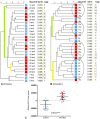Gut microbiota composition is correlated to grid floor induced stress and behavior in the BALB/c mouse
- PMID: 23056268
- PMCID: PMC3462757
- DOI: 10.1371/journal.pone.0046231
Gut microbiota composition is correlated to grid floor induced stress and behavior in the BALB/c mouse
Abstract
Stress has profound influence on the gastro-intestinal tract, the immune system and the behavior of the animal. In this study, the correlation between gut microbiota composition determined by Denaturing Grade Gel Electrophoresis (DGGE) and tag-encoded 16S rRNA gene amplicon pyrosequencing (454/FLX) and behavior in the Tripletest (Elevated Plus Maze, Light/Dark Box, and Open Field combined), the Tail Suspension Test, and Burrowing in 28 female BALB/c mice exposed to two weeks of grid floor induced stress was investigated. Cytokine and glucose levels were measured at baseline, during and after exposure to grid floor. Stressing the mice clearly changed the cecal microbiota as determined by both DGGE and pyrosequencing. Odoribacter, Alistipes and an unclassified genus from the Coriobacteriaceae family increased significantly in the grid floor housed mice. Compared to baseline, the mice exposed to grid floor housing changed the amount of time spent in the Elevated Plus Maze, in the Light/Dark Box, and burrowing behavior. The grid floor housed mice had significantly longer immobility duration in the Tail Suspension Test and increased their number of immobility episodes from baseline. Significant correlations were found between GM composition and IL-1α, IFN-γ, closed arm entries of Elevated Plus Maze, total time in Elevated Plus Maze, time spent in Light/Dark Box, and time spent in the inner zone of the Open Field as well as total time in the Open Field. Significant correlations were found to the levels of Firmicutes, e.g. various species of Ruminococccaceae and Lachnospiraceae. No significant difference was found for the evaluated cytokines, except an overall decrease in levels from baseline to end. A significant lower level of blood glucose was found in the grid floor housed mice, whereas the HbA1c level was significantly higher. It is concluded that grid floor housing changes the GM composition, which seems to influence certain anxiety-related parameters.
Conflict of interest statement
Figures







References
-
- Vael C, Desager K (2010) The importance of the development of the intestinal microbiota in infancy. Curr Opin in Pediatr 21 6: 794–800. - PubMed
-
- Elenkov IJ, Chrousos GP (1999) Stress Hormones, Th1/Th2 patterns, Pro/Anti-inflammatory Cytokines and Susceptibility to Disease. Trends Endocrin Met 10 9: 359–368. - PubMed
-
- Collins SM, Bercik P (2009) The relationship between intestinal microbiota and the central nervous system in normal gastrointestinal function and disease. Gastroenterology 136 6: 2003–2014. - PubMed
Publication types
MeSH terms
Substances
LinkOut - more resources
Full Text Sources
Medical

